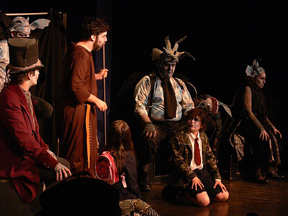
We’ve now completed four performances of The Gargoyle Garden, and each performance has been better than the previous. I feel like the production has really hit its stride–the make-up looks great, the stage action is getting sharp, the lighting crew is hitting every cue, and the singing is good.
The audience response has been phenomenal–especially from children 7 years old and above. So many of the kids have been really excited and begging to see the show again. So, I’m really gratified by that. Reactions from adults have been strongly positive, too.
But I can’t honestly say that adult reaction has been uniformly positive. We’ve had some wonderful published reviews, but we’ve also received one review that was so negative, so vicious, and so ad hominem that it bordered on a comical caricature of a critic’s bad review–think Snidely Whiplash critiquing a children’s story while twirling his mustache… Anyway, I’m not going to provide a link to that review, because I don’t want to drive web traffic to it, but if you can’t help yourself, the review may be found on Backstage magazine online.
Positive reviews of the show, on the other hand, have been numerous and very positive, indeed. Two short and simple positive reviews of The Gargoyle Garden can be found at TimeOut New York Magazine’s review of Gargoyle Garden (4 stars),  The American Theater Web’s review of Gargoyle Garden, and HyReviews of Gargoyle Garden (3 stars). There are also positive “mentions” of The Gargoyle Garden in The New York Daily News’ event and review section.
Normally, I try to stay away from reading reviews. They usually mean very little to me–either the reviewer likes my work and I can learn little from their words other than what kinds of art tickles their fancy, or the review is not positive but also useless to me. Typically, a negative review falls into two categories: 1.) a reviewer doesn’t like my work, but offers nothing constructive in his or her critique. This kind of review is maddening, because it boils down to “I hate brussels sprouts! If only they’d served me chocolate!”; or 2.) a review that focuses on everything about the performance but the artwork itself. Typical of this kind of review is “the musicians were superb and played the difficult music very well, but I found the piece boring.” or “the beautiful and mellifluous-voiced mezzo-soprano seemed to enjoy singing the work very much, but I didn’t enjoy listening to her sing the work.”
There are very few good reviewers of the arts left. Major newspapers across the country have either slashed their budgets for arts reviews or they have dropped the reviewer (and his or her reviews) completely from their staff. Most reviewers, now, are bloggers with a passion for sharing their views about something. The problem with these reviewers is that they are often inexperienced amatuers or passionate devotees of some artistic style or genre. This is not to say that these kinds of folks are incapable of offering useful and objective critiques and reviews, but, rather, that they can easily miss the mark of what a reviewer/critic can and should do for the arts–a sustained and engaged critique of the material and the reviewer’s understanding of how the work was crafted. Instead, most reviewers today tend to offer highly personal and individualistic accounts of their experiences when viewing/hearing the arts, which is about as useful to the artist as knowing that the reviewer just LOVES pepperoni pizza, but simply detests mushrooms and can’t understand why anyone would knowingly eat a saprophyte.
Occasionally, however, there is a reviewer who engages with the artwork and offers a real critique. To show you what I mean, I’d like to link to one review of The Gargoyle Garden by Kristin Hoffmann that was not exactly positive, but is a wonderful example of good reviewing. I think that Ms. Hoffmann is a little off-target on a few of her comments, but, on the other hand, I think she makes a strong case for most of the rest of her comments. What impresses me about her essay is that she finds a weakness (as opposed to a moral failing or the absence of any craft or care by an artist who may have spent weeks thinking about the problem instead of 2 minutes writing about it what they remember from last night…) and then she offers possible cures for the weakness or offers reasons why she believes the weakness occurred. So, thank you Ms. Hoffmann for a good critique!
Of course, I began all this by saying that I don’t usually read reviews… but, I’ve clearly read a bunch of them with this project. I’m not sure, exactly, why I’ve been so interested this time around. None of the reviews have really swayed me positively or negatively about my work. I’m fairly secure about my skills. I’ve been composing for years and years, so I know what my weaknesses are and aren’t. But, what I’ve noticed is that I care passionately about seeing good reviews of my collaborator, Jeff LaGreca, and his work, and I’ve also wanted to see the actors/performers get good responses, because I think they deserve them. I’ve been really happy with how hard everyone has worked on this project. So, I guess that I’m a little protective of everyone else.
There is only one show left: wednesday, August 20th, at 8:00pm. If you haven’t yet seen our work, I hope you’ll take some time to do so. Thanks to all of you who’ve been out already. We’ve had very large audiences for a Fringe Festival show, and we’ve done much better at the box office than we ever expected to do! So, thank you!